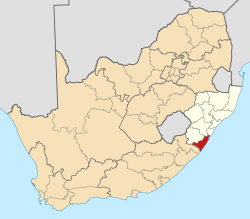History
In 1831 there was a crisis between the settlers in Port Natal (Durban) and Dingane, the Zulu king. Some settlers boarded a ship that was in the harbour and the others, including Henry Francis Fynn and his family, fled down the coast. The Zulu warriors caught up with them where Port Edward is today and massacred the fleeing settlers, which included local tribespeople of Langeni, on a hill called Isandlundlu (in English, shaped like a hut). The place has been known ever since as Tragedy Hill and its slopes are still littered with the bones of the victims.
In 1552, the Portuguese carrack "Sao Joao" ran aground at Port Edward and this is the first time in recorded history that peoples from Europe met peoples from South Africa.
In 1878, the ship "The Ivy" ran aground on Leisure Bay area beach.
In 1925, the area was partly owned by TK Pringle, [3] and he named the inland portion Banner Rest as this was where he wished to "strike his banner". The village was laid out and was named Port Edward in honour of the Prince of Wales, who later became King Edward VIII. [3]
The first holiday cottage in Port Edward was a shack built among the sand dunes in the early days by transport rider Edward Stafford. Unaware of their motility, however, he was surprised and dismayed to see his fine creation swallowed up. The area was subjected to several name changes as property was bought and sold, but the practice came to an end in 1852 when the town of Port Edward was ceremoniously dedicated to the then Prince of Wales. [4]
Tourism
Port Edward is a tourist resort for seasonal visitors from inland regions of South Africa.
There are many tourist seasons that influence Port Edward but the most significant is the Christmas/ New Year period spanning from early December to mid-January. Port Edward's Silver Beach hosts an annual New Year's Eve party frequented by youths whilst on New Year's Day itself, families populate the beach for continued celebrations.
Holiday accommodation is a particularly important source of income for the region throughout the year.
Beaches
Beaches in the greater Port Edward area include:
- Black Rock Beach [8]
- Dassie Beach [9]
- Glenmore Beach
- Ivy Beach [10]
- Kidds Beach [11]
- Leisure Beach [12]
- Munster Beach
- Palm Beach
- Port Edward Main Beach/Silver Beach: There is a ski boat launch facility at the main beach and ablution facilities. [13]
- Portobello Beach [14]
- Rennies Beach [15]
- Salmon Bay Beach [16]
- Splash Rock : Is a popular fishing destination and fishing is one of the most popular sports in Port Edward. [17]
- Spiros Rocks Beach
- T.O. Beach/Strand [18]
Attractions
- Beaver Creek Coffee Estate is a café on Izingolweni Road. It also offers visitors a daily tour of the distinctive flavours of the world's coffee regions and how the coffee production works. [19]
- Red Desert Nature Conservation Reserve is a national heritage site and is reputed to be the smallest desert in the world with a width of just 200m, and is also used for hiking and mountain biking through the extra-terrestrial terrain. [20]
- Tragedy Hill is a sightseeing spot overlooking Silver Beach. It was named after a massacre whereby Zulu warriors massacred the family of pioneer Henry Flynn due to confusion over stolen cattle. The heartbroken Zulu King ordered the man who started the rumour to be executed by one of the surviving settlers who was given 5 heads of cattle as a reward. [20]
- Umtamvuna Nature Reserve is a nature reserve located on the banks of the Mtamvuna River on the outskirts of Port Edward
- Wild Coast Sun is a casino and resort located on the opposite bank of the Mtamvuna River. It includes an 18-hole golf course and the famous Wild Waves Water Park which offers a variety of water sports. [21]
Sardine Run
Another main season coincides with the Sardine run natural phenomenon usually occurring from late May to mid-July.
This page is based on this
Wikipedia article Text is available under the
CC BY-SA 4.0 license; additional terms may apply.
Images, videos and audio are available under their respective licenses.



